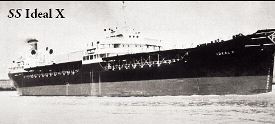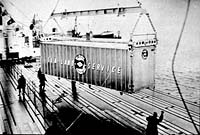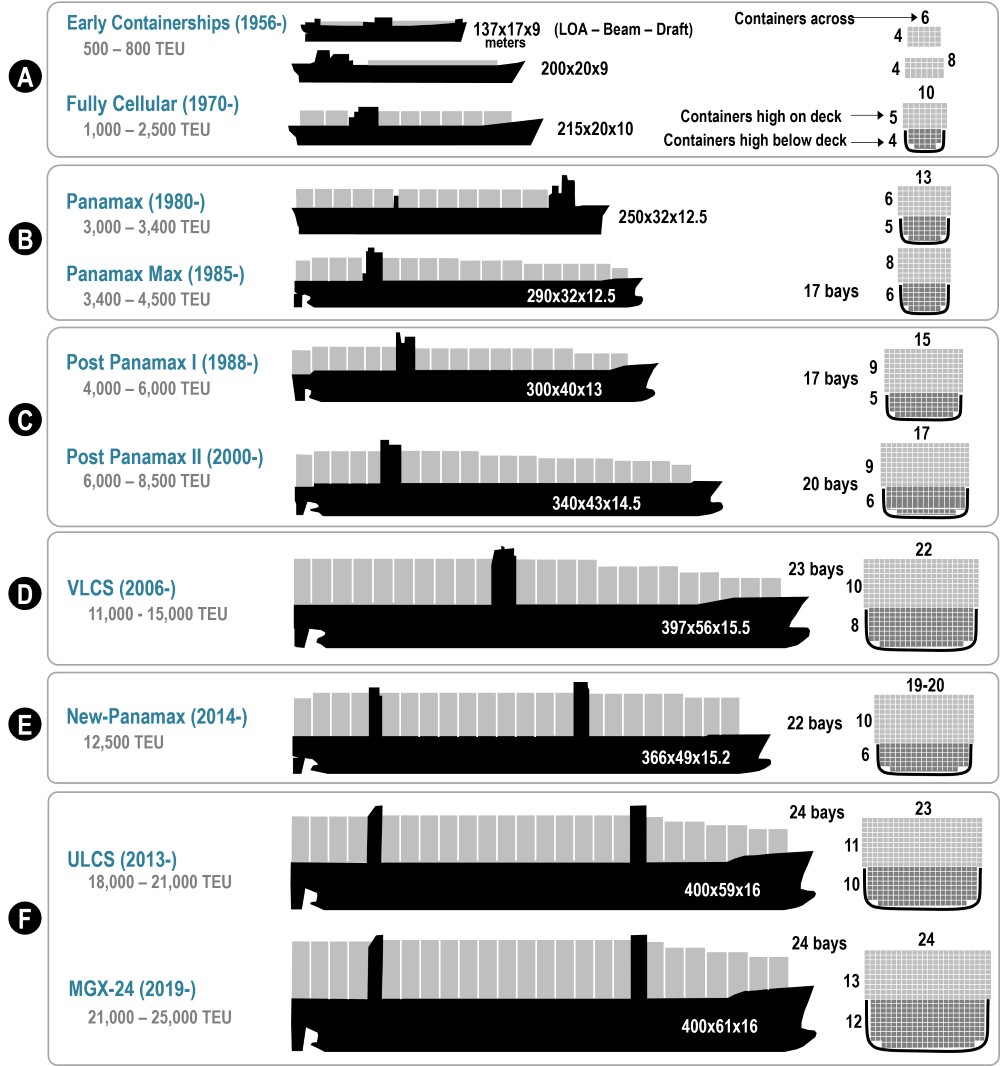Container Ships
The history of container ships began in 1956 with Ideal X, a converted T2 oil tanker whose deck had been strengthened to accommodate containers.
And here's a photo of SS Ideal X at that time:

SS Ideal X
(Source: The geography of transport systems)
The ship carried 58 35-feet (8 feet wide by 8 feet high) containers, along with a regular load of 15,000 tons of bulk petroleum from Newark, New Jersey to Houston, Texas in April 26, 1956. With the inaugural voyage of the Ideal X, the container era in world trade truly began.

Ideal X with the world's first load of containers.
Source: http://www.worldtrademag.com
You can find great information about shipping container in the book:
"The Box: How the Shipping Container Made the World Smaller
and the World Economy Bigger"
Containership generations
Containerships can be divided into development generations based on capacity, which is determined by number of TEU to carry on board.
Please note that 1 TEU is equivalent to space dominated by an ISO container with length, width, and height of 20’, 8’, and 8’6” respectively. Storage containers are transported all across the globe by large container vessels, built with enough room and weight to carry the large and heavy shipments. A container for storage can carry just about any cargo, and these massive ships were the facilitators.
Generally, there are 6 generations, each of which have a marking time and according range of capacity.

Generations of containerships
Source: The geography of transport systems
Dividing into generations like above-said is only relative, and usually used to assess the technology development in the industry. Modern liners belonging to sixth generation (over 24,000TEUs) are in operating together with smaller vessels with capacity ranging from a few hundred to thousands of TEUs.
That means, at the same time, many generations can be in service. In fact, vessels with different sizes are deployed on different routes: those with capacity of around 1,000 TEUs are suitable for feeder services, while larger ships of thousand TEUs as mother vessels can serve on trans-ocean routes.
Types of container ships
Those vessels can be categorized in several ways based on:
- development generations (as above-said)
- handling modes: LOLO, RORO
- ship sizes: Panamax, Post-Panamax, Suezmax, Post-Suezmax, Post Malacamax
- level of specializing: general cargo, semi-container, purpose-built container ships
- service range: feeder ships, mother ships
World’s container ship fleet
As of early 2024, the global fleet consists of over 6,800 container ships with a total capacity of more than 28 million TEU. The fleet is distributed across different size categories based on TEU capacity.
| Ship Type | TEU Capacity | Approx. Number of Ships | Typical Usage |
|---|---|---|---|
| Small Feeder | <1,000 TEU | ~1,200 | Short-sea shipping, regional trade |
| Feeder | 1,000 – 2,999 TEU | ~1,500 | Intra-Asia, Europe feeder services |
| Feedermax | 3,000 – 3,999 TEU | ~800 | Regional and short-haul routes |
| Panamax | 4,000 – 5,099 TEU | ~600 | Older mainline vessels, replaced by neo-Panamax |
| Neo-Panamax | 5,100 – 14,999 TEU | ~1,500 | Major trade lanes (Asia-America, Asia-Europe) |
| Post-Panamax | 15,000 – 20,000 TEU | ~700 | Asia-Europe, Transpacific |
| Ultra-Large (ULCV) | 20,000+ TEU | ~100 | Asia-Europe megaships |
World’s largest container ships over time
Since Ideal X, the first container ship set sail in 1956, the sizes and capacity of container vessel category has developed dramatically for the economy of scale.
In January 2010, MSC Daniela with public nominal capacity of 13,800 TEUs is considered one of the biggest container ships in the world. To many people, MSC Daniela is even bigger than the E-class containerships of Maersk Lines (nominal capacity of 11,000TEUs, including Emma Maersk, Elly Maersk, Regina Maersk).
Since then, the largest container ships in the world have evolved over time as shipping companies have sought greater economies of scale. Below is a timeline highlighting the largest container ships by time, based on TEU capacity:
- 2006 – Emma Maersk (15,500 TEU)
- 2013 – Maersk Mc-Kinney Møller (18,270 TEU)
- 2017 – OOCL Hong Kong (21,413 TEU)
- 2023 – MSC Irina & MSC Loreto (24,346 TEU)
Related articles
- Longest ship
- Largest ship
- Knock Nevis - World's largest ship ever
- Oasis of the Seas - Biggest cruise ship
Return from Container ships to Home Page
New! Comments
Have your say about what you just read! Leave me a comment in the box below.